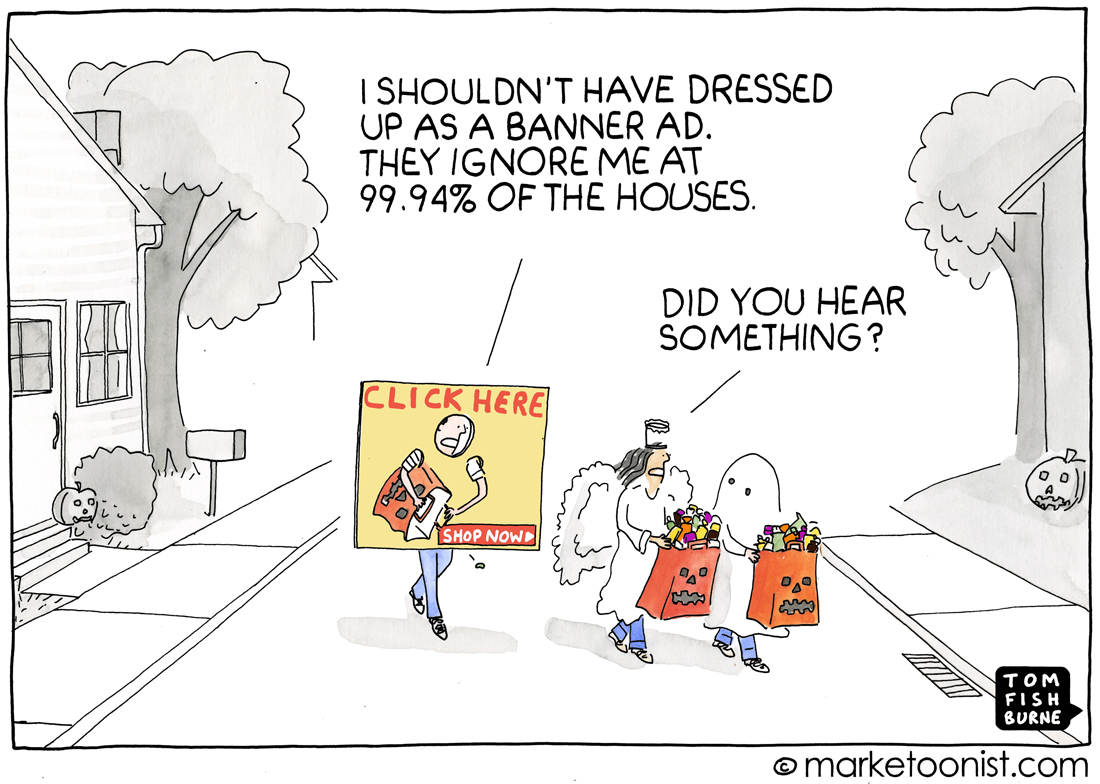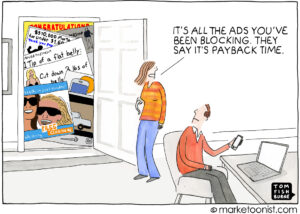The average click through rate of a banner ad is 0.06%, which I’ve heard described as lower than the average failure rate of birth control.
In the vein of my last post on Ad Blockers, I stumbled across a fascinating HBR article from Joe McCambley, one of the creators of the very first banner ad in 1994. That banner ad, for AT&T, boasted a whopping click-through rate of 44%. Joe wrote “my children tell me that’s like inventing smallpox.”
In the article, Joe describes how mobile advertising revenues are growing from $4.06 billion in 2012 to $20.89 billion in 2016. And many of those ads are descendants of the banner ad:
“Unfortunately, ad agencies have been taking the worst ad experience ever invented — banners — and simply shrinking them to fit mobile screens. For consumers who are focused on getting things done, banners are a nuisance at best, and invisible at worst. Recent studies by Trademob show that about 40% of clicks on mobile banners are due to ‘fat finger syndrome,’ meaning consumers click on mobile banners by mistake, or because advertisers trick them into clicking.”
Joe argues that marketers of the future will need to reframe the question they ask consumers from “What can I sell you?” to “How can I help you?”.
“Advertisers and their agencies, for the most part, don’t know how to be helpful. Thirty-second TV commercials, print ads, radio ads, and direct mail are all forms of content. But nobody’s addicted to them, because most ads ask, “What can I sell you?” Thousands of people have saved every issue of National Geographic in their attics. How many have saved every Viagra ad ever created?
“The future of advertising lies not in ads as we’ve known them, but in helping all those people on all those elevators get stuff done, or entertaining them. The companies and people that understand content, and utility, will be the ones to thrive … To remain relevant to consumers who spend hours each day focused on smaller screens trying to get stuff done, marketers will have to think like publishers and technology companies.”
I’d love to hear your thoughts on the future of advertising.



Neil Verma says
If 40% of the clicks are due to fat finger syndrome then how is the industry growing at such a rapid pace ? 2016 predictions are staggering!
– Neil Verma
http://www.inboundmantra.com/
Bob says
@neil – The growth rate is because a majority of companies pay based on ad clicks vs sales gained via ads clicked. The “fat finger clicks” are real numbers, actually probably on the low side, that are increasing dramatically due to ads pushed to mobile platforms. On these devices, figuring out how to close them can be nearly impossible. The numbers are not what they are because the backside sales delivery or product is subpar. Computer users know they face the peril that anytime they click a popup ad that malware, ransomware, or some other malicious exploit will be delivered to their computer. These are actual threats and why most experts in the computer field train their users to no longer click ads and popups. It is a matter of trustworthiness. I would venture to guess the actually incidental ad click rate is closer to 75 – 85% nationally, most of which are immediately closed before content is viewed.
Ori Pomerantz says
Once again, this is an issue of Capitalistic Humility(1). There are two currencies the advertiser wants from the consumer, attention and money. Getting the first is a necessary, but insufficient, condition to get the second.
The problem is that as a consumer I don’t care about the advertising. I don’t matter to me in the least that you’ve spent weeks of creating time and millions of dollars crafting the perfect campaign. I only listen to WII FM, What’s In It For Me. People in the marketing silo tend to forget that, because they are tasked with marketing, not with improving the product/service. But again, at the risk of sounding rude and selfish, that’s their problem not mine.
“To remain relevant to consumers who spend hours each day focused on smaller screens trying to get stuff done, marketers will have to think like publishers and technology companies.”
Definitely. Which means breaking down the marketing silo. Operations and development know what I want, marketing does not.
(1) The virtue of selling what others want to buy, not what you want to sell.
Stephen says
A great post and a rather crippling indictment of advertising which operates at the margins of misunderstanding by marketers who naively think that tipping money into advertising returns sales. It is a good reminder – if disheartening – that most of that $20+ billion going into advertising has little impact on customers (other than to annoy them), and is sufficient to maintain a massive industry which is at best deluding others (clients), and at worst self-delusional.
Alessio says
All true, but watch out, not all ADS are “click-objective”, or in other words, not all communication not clicked is useless… not at all.
Im not saying nothing new I know, but don’t forget. f.i. in order to get to me, companies must adv in internet, and they get to me even if I don’t click… same as outdoor adv for instance. Cheers
Bob says
Some campaigns are witty enough to capture how products changes our lives through placed stories on YouTube and such. They do so without using “Apple-isms”, those annoying trendy words and people which in no way are quantified in the ad. Others do it via assisted buy in, i.e. Microsoft’s Surface deals to basically give the devices to all NFC teams, major news networks, and other venues that will inject the product into our view without seeing the marketing. I also believe many of the best marketing strategies are the case studies that are empty of “sales lingo” and heavy of how to implement their product to solve a problem. People typically don’t know that they are being sold products, the annoyance they are trying to avoid. They see solutions only, the path to Zen.
BasisPoints says
“Reframe the question from ‘What can I sell you?’ to ‘How can I help you?'”
They’ve been teaching this in business school since at least the turn of the millennium. The real question is, “why isn’t anyone implementing what should be painfully self-evident in the first place?”
Massimo says
The only person I know who has a smart idea about the future of advertising is Don Marti. If you know how we got ourselves into this mess and only want to take a quick peek into his possible solution, go directly to Question #15.
https://www.smashwords.com/books/view/565143